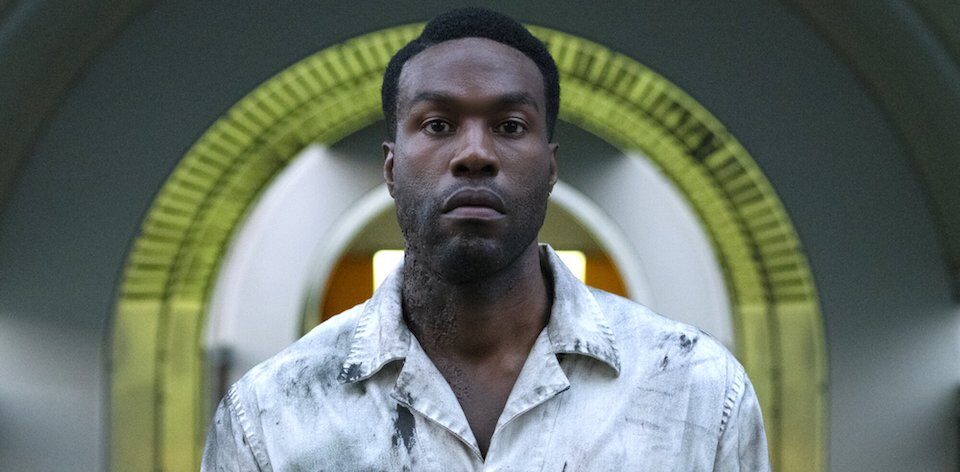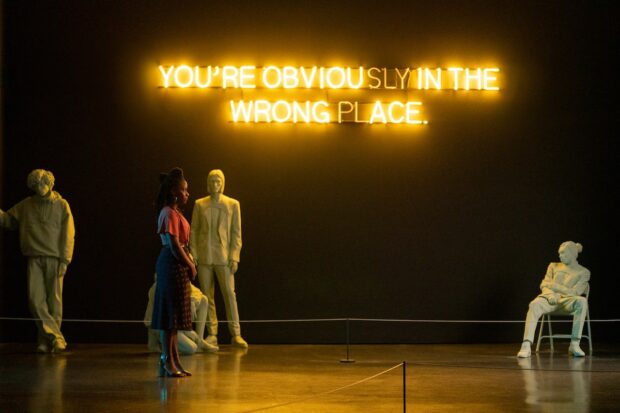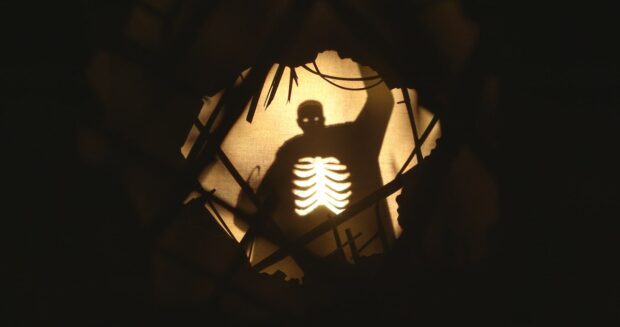In the opening moments of Nia DaCosta’s CANDYMAN sequel, two things are abundantly clear. Like the 1992 original, it’s a film about Chicago, picking up on the social impact of Cabrini-Green’s public housing development. It’s also a film that’s still very much about race and class in America, and the horrors that are even more real than a vengeful spirit that appears in mirrors.
DaCosta’s update, cowritten with Jordan Peele and Win Rosenfeld, is both a direct follow-up to Bernard Rose’s film — itself based on a Clive Barker short story — and a spiritual relaunch. From the cold open, in which we see a child’s shadow play of police terrorising the black population of Cabrini-Green in the 70s, it’s clear that the film’s core messages are also about the here and now.
The 2021 story picks up with Anthony McCoy (Yahya Abdul-Mateen II), a struggling visual artist who lives with his girlfriend Brianna Cartwright (Teyonah Parris), an art gallery director who supports his work. Anthony’s career is in arrested development until he picks up on the legend of the Candyman, the supernatural killer Daniel Robitaille (Tony Todd) who appears if you say his name in the mirror five times. As Anthony begins to explore the urban legends through his art, the Candyman is reborn in more ways than one.
Just as the original film established a firm sense of place, CANDYMAN 2021 sets out to show how the gentrification of historic black neighbourhoods have merely shifted the invisible (and sometimes very visible) class and race based lines. Indeed, long before we even get to brass tacks, we have lengthy establishing scenes in the lavish apartments and galleries of the rich. “White people built the ghetto and tore it down when they realised they built the ghetto,” say Anthony and his friends before someone asks if their rosé is still in the freezer.
When the violence begins, it is in these spaces: galleries, apartment blocks and other spaces typically protected by class privilege. The horror here, as DaCosta, Peele and Rosenfeld seem to be saying, is in those past crimes and atrocities quite literally coming back to kill us. It’s a long walk-up to get there at times, and even then some of the connective glue between scenes feels like it is missing. For example, there’s a series of asides where Anthony explores his past, and it really feels like there’s a much longer version of these sequences hanging around on the cutting room floor.
Which might be where CANDYMAN loses some modern audiences, especially those who like their slashers uncomplicated and their Candymen always visible. Reprising his role for the fourth time, Todd’s Robitaille is kept in the shadows for much of the film, taking a backseat to the personal horrors the narrative leads discover for themselves. By contrast, there’s a scene with teen girls standing in front of a bathroom mirror that seems inserted purely to add to the body count. Yet if the films Peele has previously been involved in have taught us anything, you don’t have to look far to find injustice beneath the surface.
On a technical level, it’s a slickly shot and stylish affair, with some inventive paper shadow puppet sequences recapping the past film entries, the film certainly succeeds in updating the style while remaining true to the core. Shot largely in the North Park area of Chicago, the city itself is a living entity. From the opening fog-filled shots through Chicago icons like the Marina City Towers through to exteriors elsewhere in the city, Chicago is a lead character that should get billing alongside Abdul-Mateen and Todd.
CANDYMAN is designed to be enjoyed on its own for a new generation of filmgoers, but the links it creates to the past entries serve the dual purpose of mirroring the historic and inherited nature of racial violence and prejudice in the city. Without spoiling anything here, DaCosta leaves the door wide open for future iterations and for the Candyman to return at any time. All you have to do is say his name.
2021 | USA | DIRECTOR: Nia DaCosta | WRITER: Jordan Peele, Win Rosenfeld, Nia DaCosta | CAST: Yahya Abdul-Mateen II, Teyonah Parris, Nathan Stewart-Jarrett, Colman Domingo, Tony Todd | DISTRIBUTOR: Universal Pictures | RUNNING TIME: 91 minutes | RELEASE DATE: 26 August 2021 (AUS), 27 August 2021 (US)







